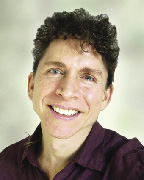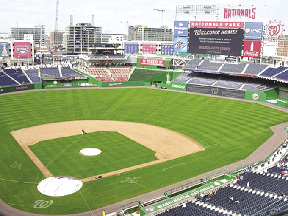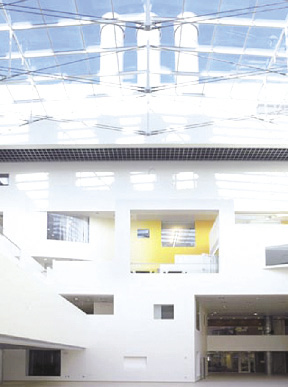The built environment accounts for nearly 45% of all CO2 emissions in the U.S. (industry and transportation - produce about 25% and 30% respectively). With climate change and global warming demanding urgent action, real estate practitioners are seeking to apply green building consciously and profitably.
This interest is reflected in real estate students coming of age during the "green revolution," and who over the next few decades will help create solutions to the climate crisis. Candidates for MIT's Master of Science in Real Estate Development are no exception. Of the roughly three dozen theses submitted this year, a substantial number address various aspects of sustainability. The three below offer just a sampling of how young professionals are responding to the need to act.
Responsibility and Potential in the Building Sector
In a thesis entitled "Global Warming, Energy Efficiency, and the Role of the Built Environment," Donna DiBona reveals the potential that real estate practitioners have for reducing greenhouse gases.
"My research examines the involved relationships between global warming, energy efficiency, and the buildings sector," she said.
DiBona's thesis shows that:
*Energy-efficiency improvements provide the most immediate means for reducing energy-related emissions.
*Energy-efficient technologies are diverse, and can be applied across all energy-related market sectors, with the greatest potential for savings coming from the demand-side or end-use sectors of transport, industry, and buildings.
*Of all sectors studied, the buildings sector adheres most closely to the goals of policy-makers in reducing greenhouse gas emissions; its technologies are proven and readily available, are the most cost-effective, require the lowest investment cost, and can be implemented for immediate effect.
*The buildings sector also offers the greatest emissions reduction potential at the lowest cost in the short-term.
*The reduction of these emissions within the buildings sector relates directly to the abatement of global warming.
Although the built environment presents great opportunities for conservation, a barrier to implementation is insufficient public awareness - the need for change in consumer behavior.
To fully realize emissions reductions, this barrier must be addressed through stronger policy initiatives, which can curb the consumption of energy and the emission of greenhouse gases through, for example, financial incentives and penalties. DiBona sums up this way: "Complacency is not an option."
Greening Existing Office Buildings
Research by Tyson Dirksen and Mark McGowan considers the greening of the built environment by focusing on existing buildings (EB), and in particular, multi-tenanted office buildings.
In their joint thesis, "Greening Existing Buildings with LEED-EB!" the authors find that a far higher percentage of owners and managers of class A office building are pursuing LEED for Existing Building (LEED-EB) certification, in contrast with their counterparts in class B buildings. "The first adopters of green standards in commercial multi-tenant office space are in the class A market," they said, "on both the ownership and tenant side."
"The owners of quality class A office space want to differentiate their buildings in the market," they said. "And their tenants are firms whose employees are their biggest asset. They use their facilities to recruit potential employees." Especially if employers want their staff to work long, hard, and productively, it's imperative that the office space be healthy, comfortable, and have lower operating costs.
Class B owners have fewer incentives and greater obstacles when pursuing LEED-EB certification. The buildings tend to be older and less energy-efficient; fewer staff are available to monitor and improve environmental performance. "Tenants of class B space are generally looking more for value than quality," Dirksen and McGowan said.
This led the authors to explore two creative ways for class B owners to participate in greening their buildings without significant capital or engineering knowledge. Energy Savings Performance Contracts can help building owners upgrade their building systems and decrease operating expenses. Power Purchase Agreements can help introduce on-site power generation for little or no upfront cost.
"To keep this market segment engaged, the USGBC would be well served to identify clear paths for B owners to achieve certification," they said.
Fenway Park & Other Stadiums: Unique Greening Opportunities
Because of their sheer size, variable climates, and unusual usage patterns, stadiums pose special obstacles to going green. But there's a payoff: sports arenas are high profile structures receiving intense media scrutiny, and owners increasingly recognize that going green (and bragging about it) can enhance public perception.
In a thesis entitled "Greening Stadiums: A Study of Environmentally-Responsible Methods of Building and Retro-Fitting Stadiums," Peter Vanderweil investigated examples of green-friendly designs and operations, using studies of Fenway and other stadiums to illustrate barriers and benefits to greening.
As the nation's oldest major league ballpark, Fenway is both a historical treasure and a challenge to green solutions. But enhancing the existing structure is "the purest form of sustainable building practice," according to its architects, "keeping the embodied energy intact and avoiding the pollution and waste that result from creating a new structure out of the ground." Green innovations at Fenway have focused on retrofitting:
*Chiller Augmentation: Reducing energy consumption by augmenting the park's massive 240-ton chiller with an auxiliary 40-ton chiller that can be used during off-hours.
*Lighting Efficiency Upgrades: Installing more efficient LED lighting, which offers immediate cost/benefit payoffs estimated at $32,000/year per sign.
*Low-Flow Plumbing Fixtures: Increasing the number of fixtures in the park without expanding its overall water capacity.
*New Power Substation: Installing a new 480V electrical substation in right field to enable more efficient electrical delivery to the park's "home run zone."
*Seating Resale: Selling the old bleacher seats to fans when replacing them in 2007, diverting tons of waste from local landfills while subsidizing the new seats.
*Solar Energy: Installing solar thermal panels above Fenway's press box to decrease hot water costs by 37%, and natural gas-related CO2 emissions by 18 tons per year.
Vanderweil's study also considers the brand new Washington Nationals ballpark - an LEED-Silver stadium built on a brownfield - and other examples of how sports arenas can capitalize on their high visibility to advance the green revolution.
Michael Mack is an affiliate writer for the MIT Center for Real Estate, Cambridge, Mass.











